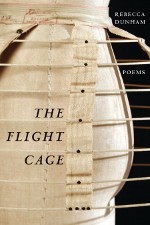Rebecca Dunham: The Flight Cage
Rebecca Dunham’s The Flight Cage is thick with historical touchstones: Frank Baker’s "Flight Cage" of 1904, Ghyka’s The Geometry of Art and Life, the Salem Witch Trials—and is peopled with the voices of Ann Putnam, Sarah Good, Dorothy Wordsworth, Elsie Viola Kachel (wife to the poet Wallace Stevens), and what seems like the whole cast of Mary Wollenstonecraft’s acquaintance (her sister Bess, Fanny Blood, her daughter—the future Mary Shelley). Though the swirl of allusions and epigraphs in this book can get a bit daunting, Dunham does a fine job weaving their voices and her own into a cohesive sensibility, and marking common threads that hold the book together. Flight Cage capitalizes most on its motifs: ash, flowers, clay, birds, cages and ribcages all repeat throughout the book’s sections in a way that layers and builds upon the cyclical nature of human existence and the sense of a shared female experience that is its book focus.
Dunham is at her best in The Flight Cage when her poems occupy their most desperate spaces. "Mary Wollenstonecraft in Flight" and "Confinement Ghazal" are two knockouts, the first being the book’s opening poem, which combines the urgency of Wollenstonecraft’s second attempted suicide with Dunham’s meticulous ear for both internal rhyme and end-rhyme (which she seems to love placing in final couplets throughout this book) :
… I will not be confined,
content to peacock and preen
my manifold eyes. These storm-
soaked skirts will ballast
my fall, plumb as bridge pilings.
I have nothing
to fear from water’s mean slap.
Let my lungs be coin-heavy.
Let their two ruched pouches
swell pink and full as I sink, let
Putney Bridge be my final perch
and the October wind, my screech.
Dunham’s ear rarely fails her in this collection; a few lines I particularly love re-reading are: "Rack of lamb: its barred cage breaks" (35), "Brick and butter leaves thread / the breeze that banners our side porch, / picking up speed" (19) and great swaths of the second poem in the section "A Short Residence," where syntax perfectly enacts a bullheaded kind of frustration in the penultimate stanza, and where the final stanza (both below) is dense with pleasing alliteration:
… On X-rays
my bones beam white and that is how
I know they run like char beneath my skin.
Don’t talk to me of science. I will talk
as dark as I want and to myself or
pay someone to listen. I am not afraid
at the expense. Death is a subtraction.
It draws us, massing and flocked, iron
filings thick as flesh-fly’s larvae
on last fall’s rodents. The ones we killed
into curls and left within our walls.
If I have a complaint about Dunham’s Flight Cage, it is simply that her project often seems to butt heads with the kind of scope she’s aiming for. For example, the book’s central sequence, "A Short Residence," consists of twenty-five fifteen-line poems, structured in quintains. Each of the poems borrows language from a corresponding letter from one of Mary Wollenstonecraft’s Letters Written During a Short Residence in Sweden, Norway, and Denmark. At first, it’s hard to shake the feeling that these poems are interpretations or recreations of the letters, maybe even persona poems, except that they’re full of anachronisms: "the swimming / pool liner’s cloudless sky" (25), "we turn / the air on" (26), or "the skirt of her swimsuit, / its shining polyester petaled primrose" (36). Despite their historical context and content, these poems ultimately seem to belong to a separate narrative than Wollenstonecraft’s. However, there’s a tonal disjunction that occurs when the contemporary narrative is woven with language from the letters; Dunham has had to do some amount of work unifying the tone of those two contrasting sources, and as a result we get occasionally inflated language in the speaker’s voice, as in: "I tend my bulb garden […] / beneath the sky’s blue vault" (33); or some areas that, combined with Dunham’s sense of rhyme, teeter a bit close to anachronism themselves in their style: "I have no windows, no way / to confirm the hands on the clock / stand true, that anything here is above / being bought, being subdued," (39). These contradictions in persona lead me to feel a little disoriented throughout the book’s central sequence.
Likewise, the poems in Flight Cage are occasionally choked by specificity. Though the intended historic referents are clear, I often wonder why we need, mid-poem, to be reminded of Thales of Miletus or Luigi Galvani, or Convento de Carmo, or why we need to know specific details of the "pink zippered robe, brown / along the hem" (43) at the kitchen table.
All said, the sixty-some pages of this book are attentively wrought and incisive in their insights (" … O hate, Its thin mercy / cushions hip and shoulder bone," p. 6), and the breadth of Dunham’s historical attention could easily serve as the basis for a lifetime of rewarding study, though it wouldn’t as satisfying as the sensation of experiencing it all seemingly firsthand, through Dunham’s whip-like, ringing verse.
 Rebecca Dunham
Rebecca Dunham